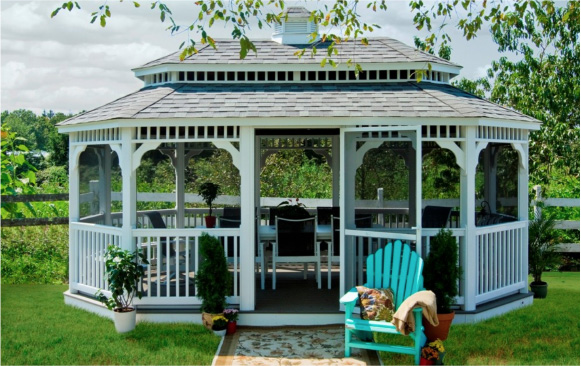Extend Your Summer Season with Outdoor Living Space Transformations
By Nikki Alvin-Smith
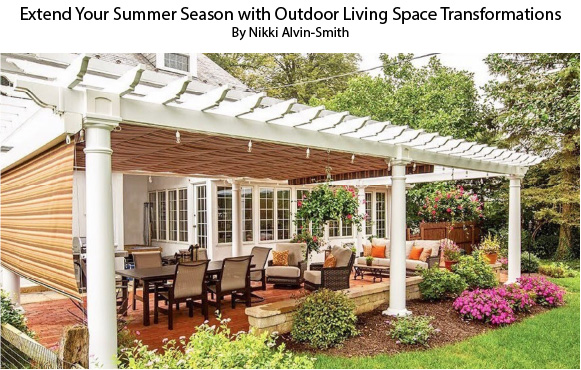
Many backyards and garden spaces are totally underutilized. Outside living is a great way to embrace a healthy lifestyle, but that is not all it offers. Extending living areas to outside your home has hidden benefits.
Outdoor space is often more generous than the confines of the interior of the home and offers the opportunity to invite larger gatherings of family and friends. Aside from the fresh air and feeling of wellbeing that being outside brings to the soul. The focus of the property owner is often directed to the inside space and many people simply don’t realize so much can be done to enhance the ownership experience of their overall property.
No matter how big or how tiny, outdoor space can easily be incorporated into the daily lifestyle to create a positive way of life.
Outdoor living is also user-friendly for the younger visitors, as there is room to let children burn off excess energy and spills and accidents are more easily cleaned up.
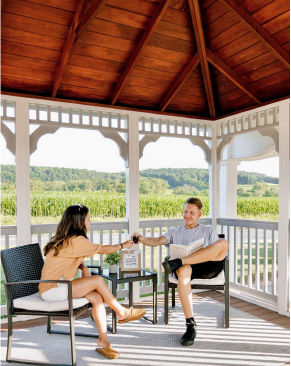 Adults tend to spend more time in conversation when seated comfortably outside. Distractions such as tablets and phones can be set aside, TVs are usually absent (although can be added for the sport day afternoons and special events), and the quieter environment offers more likelihood of communication.
Adults tend to spend more time in conversation when seated comfortably outside. Distractions such as tablets and phones can be set aside, TVs are usually absent (although can be added for the sport day afternoons and special events), and the quieter environment offers more likelihood of communication.
The inclusion of pretty flowers and shrubbery and landscaping in general, including a designated patio area with hard landscaping that may even include a rill or pond with a running water feature, will provide privacy and tranquility. A skillfully orchestrated backyard garden can offer a place to retreat from the stress of hectic lives and provide an environment for the weary to reboot and recharge.
An outdoor living space must offer all aspects of comfort to be successful. Seating that provides comfort, dining and side tables, plus shelter from the unexpected rain shower and the heat of the sun are all important elements of a good backyard design.
Seating should be varied in its design to accommodate different purposes and people of different age groups. Outdoor furniture such as sofas, sun chaises, hammocks, beanbags, benches and café chairs can be carefully crafted within a garden space to offer multiple options. Different areas can be created for relaxing, dining and socializing.
Low walls can provide great additional seating spots for larger gatherings such as graduations and bridal showers.
Outdoor rugs can be used to segment spaces, and the backyard space should offer an inviting tone with soft touches like blanket throws, cushions. Textiles can be chosen to provide texture and add vibrant colors to gardens or smaller spaces that lack colorful plantings.
A heating unit such as a fire pit or propane heater can offer warmth during the early evening when the dew falls. A cooking medium such as a barbecue, can ensure the cook(s) in the family can participate more fully in hosted events.
Sidebar: Always ensure there is adult supervision of any fire source at all times for safety.
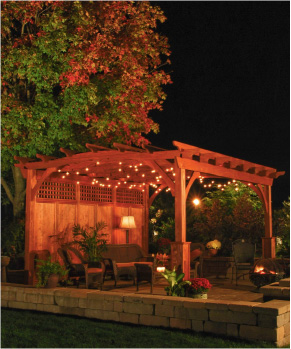 Of course as the summer season wanes the nights draw in during the Fall, so the addition of exterior lighting will extend the use of the outdoor living space. Lighting can be used to both create a romantic mood as well as be of practical use.
Of course as the summer season wanes the nights draw in during the Fall, so the addition of exterior lighting will extend the use of the outdoor living space. Lighting can be used to both create a romantic mood as well as be of practical use.
Think outside the box and incorporate what works for your family. Outdoor cinemas can be easily created on a white wall; fairy lights can create a magical feel; and scented candles and nearby plantings of petunias, wisteria, and honeysuckle and fragrant herbs will provide a natural sweet scent in the evening.
Say Goodbye to a Dreary Backyard
Is your backyard dreary? A boring patch of lawn with one or two ornamental trees, a space poorly and cheaply designed by the developer that is identical to your neighbor’s? Does your backyard design lack any sense of purpose? Is it just a place to let the kids and dog play in good weather with no real function or formality? Is it tired and overgrown?
Interestingly a well-landscaped garden can add more than 14% to your property value, but more importantly, a good garden layout design can add much enjoyment to your lifestyle and create a theater or stage on which delightful activities can unfold throughout more than one season.
Beautifying your backyard is not as complicated or necessarily as expensive as you might think, and many aspects can be completed yourself with a bit of professional input.
The topic of landscaping can be overwhelming and is certainly extensive when it comes to the soft landscaping of the flora. Here we’ll focus on hard landscaping features that truly are where you should begin in your garden design, and in particular outdoor living structures, rather than pathways, walls, ponds and other immovable factors in the design.
Design Your Space Ahead of Time
There are computer programs that are available to help you design your garden space, but working at the kitchen table with a piece of graph paper, pencil (and don’t forget the eraser you’ll be needing it), can service your needs nicely.
Begin by making an accurate to scale drawing of your outdoor space. Take into account any underground services such as septic or sewer lines, electrical or cable and telephone access and mark them clearly so you don’t forget their existence later.
The height of a building can impact clearance to overhead power lines, buried services may need to be excavated at a later juncture for repair, and so avoiding placement of a structure underneath or above these areas is essential. If you aren’t certain where these services are situated, call the nationwide service on 811, to have local utility companies come and mark the location of any water, sewer, or electrical lines before construction begins.
Consideration of drainage is also important when it comes to choosing a site for your structure(s). A level, well-drained site is essential. You want to be able to access your building in all weathers and it needs to offer appropriate access size. This will be dictated by the intended use of the structure.
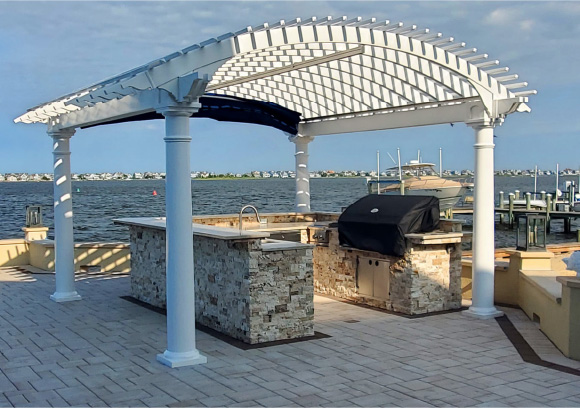
Decision-making for your outdoor living structure should include future needs. If your kids are in their teenage years then in the near future you’ll be hosting all manner of parties. Graduation, engagements, weddings, bar mitzvahs, christenings, baby showers, and an array of seasonal activities can be accommodated with the provision of a pavilion.
If you have or plan to add a pool, a cabana can make life much more tolerable when folks come to splash about in your backyard. The ‘dripping’ guest can simply change outside and you won’t need to clean up after them.
If you like to entertain on a grand scale, a pavilion with an outdoor kitchen and full electric service can provide a valuable addition to your events. For businesses outside structures can be used all year around, clam bakes, July 4th celebrations, Halloween apple and doughnut parties, Santa Clause appearances.
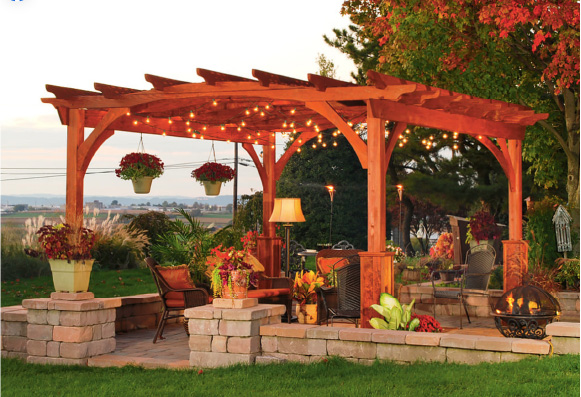
Here is a checklist of helpful factors to consider:
• Identify top priority use
• Determine size to best fit purpose
• Determine type of structure to best fulfill function
• Site plan your property for location bearing in mind future building needs. Do not place structure over buried service lines if possible.
• Source a large manufacturer that offers the most advanced options and customization
• Review their offerings with a view to price. Bear in mind cheapest may not be better, compare quality of materials and craftsmanship, warranties offered.
• Request pricing, contract terms, delivery and setup costs and timeline for supply
• Review their customer satisfaction ratings through BBB (Better Business Bureau), testimonials, and online reviews
• Identify your budget constraints and resource financing if needed. Leading structure manufactures usually offer financing options
• Check with your local authorities for planning permissions or permits required. Many companies will provide plans at nominal charge.
• Ensure your preferred site is accessible by talking with the manufacturer about needs and delivery aspect
• Once structure is purchased prepare the site as per manufacturer’s directions. Larger manufacturers can provide help/liaison with your construction company or in some cases provide same themselves
• Sit back, await delivery and make plans for its use!
Create A Feeling Of Privacy
It is an inconvenient truth that size matters when it comes to defining your garden space if you want it to provide a feeling of intimacy and enclosure. It is generally accepted that the vertical edge of the space is at least one-third of the length of the horizontal space in order for us to feel properly at home in our garden.
This means that whatever shape your garden, you can divide it with hard landscape features such as walls or buildings, rockeries or soft landscaping touches like hedges, to provide a sense that you are inhabiting the space.
When you think about adding a gazebo or cabana, there will be ‘hard’ walls that can provide this division. For pergolas and pavilions, their more open nature will still provide the necessary separation, especially if the pillars are extended in their appearance by soft climbing plants and arbors are created.
Think in 3-D
The actual space that a structure demands at ground level can be made to appear less or more than it actually is, by adding more or less height. The color of the structure is also important not just for aesthetic appeal to complement the house in style and design, but also to convey how dominant the structure is in the garden space. Darker colors will appear smaller and lighter colors will appear larger.
Similarly complex designs will appear smaller than simpler designs.
When determining heights and square foot size the governance of both needs to address proportion to other existing structures like the house or garage.
Case in point: An acquaintance of mine who is in the construction business, recently built a beautiful pergola on his deck adjacent to his one story home. He proudly displayed his creation and it was indeed beautifully crafted. However, the height of the rafters of the pergola set independently from the home, were significantly higher then even the gable height of the house. This unfortunately made the pergola look slightly ridiculous.
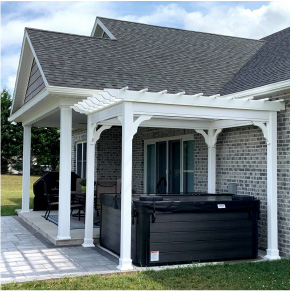 The further away from your home the outdoor living structure is placed, the more freedom you will have to size it how you want without as much consideration of the height and style of the existing house. However there can be a lot of fetch and carry involved in outside living so consider distance to the existing kitchen. Tip: Keep a supply of pitchers and trays handy for outdoor entertaining.
The further away from your home the outdoor living structure is placed, the more freedom you will have to size it how you want without as much consideration of the height and style of the existing house. However there can be a lot of fetch and carry involved in outside living so consider distance to the existing kitchen. Tip: Keep a supply of pitchers and trays handy for outdoor entertaining.
It is important to assess what is in your line of sight from the house and what structures may be close to the one you are proposing. If a neighbor has a Victorian style garage the other side of the property line, adding a modern PVC pavilion may look out odd if placed in front of it.
For the structure itself (and indeed for lawns, beds, patios as well as arbors etc.), the rule of proportion should also be implemented. This is a rectangular ratio and is close to 1: 1.6. So ideally a 10’ wide pergola, would be 16’ long.
Type of Structure & Materials Matter For Longevity
Quality construction is obviously important whatever materials you choose. Materials chosen also significantly affect the longevity of the building. Aspects of maintenance such as staining and painting, inherent insect and weather resistance that is found in cedar and locust, hardwoods like oak versus softwoods like pine, all factor in to the longevity of the building.
The type of outdoor living structure chosen will also impact longevity. Pergolas are more exposed and offer less structural integrity than a pavilion, while a gazebo offers more than both.
DIY or Professional Build
The average do-it-yourselfer may contemplate the build of an outdoor living structure as being easy to complete. However, the task may not be quite as straightforward as it seems at first glance.
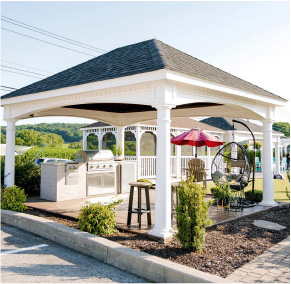 Complex rooflines such as octagonal gazebos require precision in both design and carpentry skills. Pavilions offer a spacious feel and are flexible when it comes to accommodating different size gatherings. In order to handle regional snowfall loads or hurricane requirements any structure needs to be properly designed and constructed.
Complex rooflines such as octagonal gazebos require precision in both design and carpentry skills. Pavilions offer a spacious feel and are flexible when it comes to accommodating different size gatherings. In order to handle regional snowfall loads or hurricane requirements any structure needs to be properly designed and constructed.
If you opt for a kit purchase, ensure that it meets local codes and for any building make sure you’ve checked out the permitting requirements before you make a purchase.
A prefab or modular company has a keen timeline on production and delivery and a factory environment where quality control is easy to manage. Buying from a prefab company is a quick and easy way to enjoy an ‘instant’ hard structure in your garden and it can save on labor costs and expensive mistakes in joinery work that waste time and materials, making it a cost effective solution to your hard landscaping needs.
When it comes to saving money in your garden design, you are better off cutting expenses in areas such as gravel versus stone paths and a smaller budget for flora than in a permanent building such as an outdoor structure.
Excited to Get Started?
The actual production of your garden should be enjoyable, and while it is essential to have your Master Plan in place, achieving your goals can be made incrementally with ‘small steps.’
Be careful not to be ‘led down the garden path’ on misadventures or disappointments when you are shopping. Choose a great partner for your project who has a proven track record with delivery on time, on price point and on spec.
When you work directly with an experienced manufacturer, your options for customization are magnified and your likelihood of a misstep minimized.
If you are buying multiple structures from one source at the same time, don’t forget to ask about quantity discounts and possible extra upgrades that could be included such as screens in gazebos.
The ‘great’ in the expression ‘great outdoors’, does not have to mean hiking a trail in 90 degree weather or lining up for endless hours to take a plane ride. It truly is, right outside your back door. Live it everyday!
